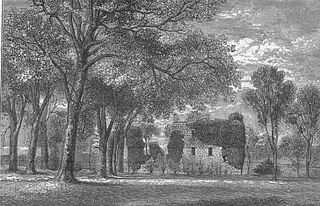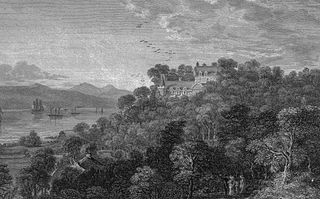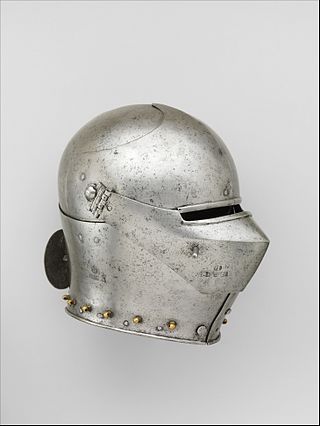The Skelmorlie Aisle of Largs Old Kirk is the remains of a church in the town of Largs, Ayrshire, Scotland.
Contents
- History
- The Montgomerie tomb
- Painted ceiling
- Access
- See also
- References
- Notes
- Sources
- Further reading
- External links

The Skelmorlie Aisle of Largs Old Kirk is the remains of a church in the town of Largs, Ayrshire, Scotland.

The majority of the kirk (church) was demolished in 1802 when the new parish church came into use, but the aisle, a division of the once larger building containing the mausoleum, was retained.


The Skelmorlie Aisle contains a notable monument built by a local landowner, Sir Robert Montgomerie of Skelmorlie Castle, seventh Laird of Skelmorlie, as a burial site for himself and his wife, Dame Margaret Douglas. [1] The aisle was added to the old kirk (church) of Largs in 1636, and comprises a Renaissance canopied tomb above the burial-vault entrance. The barrel vaulted ceiling of the aisle was painted 1638 in panels, with heraldic emblems and signs of the Zodiac, etc. by a Mr. Stalker. [2] A third coffin within the tomb is said to be that of Sir Hugh Montgomerie of Eaglesham, a hero of the Battle of Otterburn. [1] It can be compared with other significant tombs, such as that of the Cunninghames, Earls of Glencairn at Kilmaurs in East Ayrshire.
Sir Robert's coffin is especially long and much of the lead on the bottom of the coffin is missing, supposedly taken by local fishermen who believed that lead weights made from it would result in a large catch of fish. [1]
The painted timber ceiling is signed and dated 1638 by J. Stalker and is in vernacular contrast, albeit the designs are derived from the work of a goldsmith at the French royal court, Etienne Delaune. [3] Lively scenes illustrate the seasons as well as the Montgomerie and Douglas conjoined coat of arms, oddly with the quarters of the Montgomerie arms incorrectly placed as in the Polnoon example. The arms in the panel above the entrance door also have this 'mirror image' arrangement. [4] James Stalker was a former apprentice of an Edinburgh painter, John Sawers. His work seems to be otherwise unrecorded. [5]

Today Skelmorlie Aisle is in the care of Historic Environment Scotland. Admission is free, although visitors need to be accompanied by a guide from the adjoining Largs Museum. Both the kirkyard and museum are open from Easter until late September on Thursdays, Fridays, Saturdays, and Sundays from 1:30pm to 4.30pm. [6]

Skelmorlie is a village in North Ayrshire in the southwest of Scotland. Although it is the northernmost settlement in the council area of North Ayrshire, it is contiguous with Wemyss Bay, which is in Inverclyde. The dividing line is the Kelly Burn, which flows into the Firth of Clyde just south of the Rothesay ferry terminal. Despite their proximity, the two villages have historically been divided, Skelmorlie in Ayrshire and Wemyss Bay in Renfrewshire.

Largs is a town on the Firth of Clyde in North Ayrshire, Scotland, about 33 mi (53 km) from Glasgow. The original name means "the slopes" in Scottish Gaelic.

William Cunningham, 9th Earl of Glencairn (1610–1664), was a Scottish nobleman, Lord Chancellor of Scotland, and a cavalier. He was also the chief of Clan Cunningham.

Kilmaurs is a village in East Ayrshire, Scotland which lies just outside of the largest settlement in East Ayrshire, Kilmarnock. It lies on the Carmel Water, 21 miles southwest of Glasgow. Population recorded for the village in the 2001 Census recorded 2,601 people resided in the village It was in the Civil Parish of Kilmaurs.

Clan Cunningham is a Scottish clan. The traditional origins of the clan are placed in the 12th century. However, the first contemporary record of the clan chiefs is in the thirteenth century. The chiefs of the Clan Cunningham supported Robert the Bruce during the Wars of Scottish Independence. In the 15th and 16th centuries, the Clan Cunningham feuded with the Clan Montgomery. Historically, the chief of Clan Cunningham held the title of Earl of Glencairn. However, in modern times the chief of the clan is Cunningham of Corsehill. On 18 December 2013, Sir John Christopher Foggo Montgomery Cunninghame, Baronet of Corsehill, was recognized by Lord Lyon as Clan Chief after the chiefship had been vacant for over 200 years.

The old Barony and castle of Corsehill lay within the feudal Baillerie of Cunninghame, near Stewarton, now East Ayrshire, Scotland.

Clan Montgomery is a Scottish clan of the Scottish Lowlands.

Hessilhead is in Beith, North Ayrshire, Scotland. Hessilhead used to be called Hazlehead or Hasslehead. The lands were part of the Lordship of Giffen, and the Barony of Hessilhead, within the Baillerie of Cunninghame and the Parish of Beith. The castle was situated at grid reference NS380532.

Kilwinning Abbey is a ruined abbey located in the centre of the town of Kilwinning, North Ayrshire.
Kilmaurs Place, The Place or Kilmaurs House, is an old mansion house and the ruins of Kilmaurs Tower grid reference NS41234112 are partly incorporated, Kilmaurs, East Ayrshire, Scotland. The house stands on a prominence above the Carmel Water and has a commanding view of the surrounding area. Once the seat of the Cunningham Earls of Glencairn it ceased to be the main residence after 1484 when Finlaystone became the family seat. Not to be confused with Kilmaurs Castle that stood on the lands of Jocksthorn Farm.

Montgreenan is an estate in North Ayrshire, Parish of Kilwinning, Scotland. The Lugton Water runs through the policies and farmland of Montgreenan. Nearby are the hamlets of Torranyard and Auchentiber.

Kennox House is situated on Kilwinning Road between Stewarton to Torranyard in North Ayrshire, Parish of Dunlop, Scotland. The house overlooks the Glazert Burn, which runs into the Annick Water at Watermeetings.

Skelmorlie Castle stands on the eastern shore of the Firth of Clyde, Scotland, at the north-western corner of the county of Ayrshire. The structure dates from 1502, and was formerly the seat and stronghold of the Montgomery Clan. The modern village of Skelmorlie lies to the north of the castle.

Polnoon Castle was a 14th-century fortification located on a motte beside the Polnoon Water in Millhall, in the Parish of Eaglesham, East Renfrewshire, Scotland.

The Lands of Lainshaw lie in Strathannick and were part of the Lordship of Stewarton, in East Ayrshire, Scotland. Lainshaw House is a category B listed mansion, lying in a prominent position above the Annick Water and its holm in the Parish of Stewarton, Scotland. Part of the much older Lainshaw Castle is contained within the several later building phases of the present day Lainshaw House. The names 'Langshaw' or 'Langschaw' were used in historic times. Law Mount near the High and Laigh Castleton farms has been suggested as the site of the original castle, granted in the 12th century to Godfrey de Ross by Hugo de Morville.

The Brisbane Aisle is a small 17th century free-standing burial vault, built for the Shaws of Kelsoland and situated in the grounds of the 'Largs Old Kirk', Largs, Ayrshire, Scotland.

The Murder of Hugh Montgomerie, 4th Earl of Eglinton at the Annick Ford in Stewarton, East Ayrshire, Scotland, took place in 1586 as a consequence of a long running feud between the Montgomeries, Earls of Eglinton and the Cunninghames, Earls of Glencairn, families who were competing for power and influence locally and nationally. The significant repercussions of this act were felt throughout the county of Ayrshire and beyond. The spelling 'Montgomerie' is used throughout for both the family and Montgomery for the clan and clan and district names 'Cunninghame' in the same fashion.

Funerary Helmets,Mortuary Helms, or Mort Helms were the major element of a suit of armour that was most often placed above or near the carved memorial effigy of the knights or members of the nobility concerned in a tradition that ran from at least the 14th through to the 17th century, particularly when the person concerned had gained a reputation in life as a warrior. These helmets were often brightly painted or otherwise ornamented with floral designs, etc. Largely located within rural churches and other religious buildings, the practice was especially common in the south-west English counties and Cornwall with only a few examples known from Scotland.

The Glencairn Aisle or Glencairn Vault at Kilmaurs, East Ayrshire is a Category B Listed vaulted sepulchral chapel built as a place for private contemplation and prayer that also contains a large memorial monument, as well as the burial crypt of the Cunningham Earls of Glencairn and their family members. An 'Aisle' is defined as a structure normally attached to a church, which may have burial crypt below, a family pew above, and sometimes a retiring room as at the Glencairn Aisle.

The Kennedy Aisle or Bargany Aisle at Ballantrae, South Ayrshire is a vaulted burial chamber and crypt containing a large mural memorial, the Kennedy Monument, an ornately carved stone monument dated to between 1602 and 1605 that commemorates Gilbert Kennedy of Bargany and Ardstinchar, his wife, Janet or Jean Stewart, who died in 1605 and three of their children.